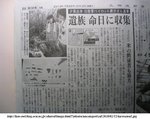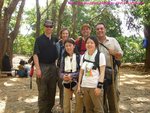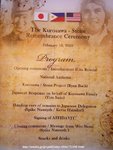syscom3
Pacific Historian
WWII dogfight plane found | Manila Bulletin
By MAR T. SUPNAD
February 12, 2010, 5:17pm
MARIVELES, Bataan — The wreckage of a World War II Japanese bomber plane and the skeletal remains of its pilot who engaged in a historic dogfight with an American aviator during World War II has been found accidentally in a forested area here.
The remains have been turned over the other day to the relatives of the Japanese pilot who came here all the way from Japan for the nostalgic occasion.
The remains of Sgt. Toshishada Kurusawa and the wreckage of his Tora-Tora plane were found by a team of Stone/Kurusawa, a joint American and Japanese expedition headed by American national Spike Nasmyth who started the expedition project, called the "Great Discovery", way back in 2006.
The group was actually searching for the remains of American pilot 2nd Lt. Earl Stone who was killed in the dogfight with the Japanese plane on February 9, 1942. Instead, they found the wreckage of the Japanese plane, followed by the skeletal remains of Kurusawa.
Noel Duero, an Aeta volunteer, told the group that they were able to locate the Japanese plane's wreckage, together with the remains of Kurusawa, partially buried at the top of Mt. Tarak here.
Nasmyth said the discovery of the wreckage will certainly impact World War II history. It was earlier considered that there was no more hope of recovering the two war planes that engaged in the famous, deadly dogfight at the height of the war in the Pacific theater.
"There are many books written about that story... all the books say the same: No remains ever found of Earl Stone or his plane.
"Now we're re-writing the books; we can say and tell now, we found it. It is a great discovery," Nasmyth said.
The turnover of the Japanese remains was witnessed by Mrs. Vicky Garcia, Chair of Bataan Tourism and wife of Governor Enrique Garcia, and Mayor Jesse Concepcion of this historical town.
Edna Bautista Binkowski, a native of Limay town and author of a book entitled "American Espionage and the Japanese Forces", was reportedly able to interview a number of surviving American pilots who witnessed and narrated the famous dogfight in Mt. Tarak.
Nasmyth admitted to newsmen that the discovery of the Japanese plane was accidental since they were looking for the wreckage of the American plane that went down in flames after a huge explosion in the air.
"We were not looking for the Jap's plane, so we thought we found Earl Stone's plane; we were surprise when we found the round radial engine which was not the same kind of plane used by the American forces," said Nasmyth.
The relatives of the Japanese pilot were nevertheless glad to recover Kurusawa's remains and said their travel from Hokkaido, Japan was well worth it.
By MAR T. SUPNAD
February 12, 2010, 5:17pm
MARIVELES, Bataan — The wreckage of a World War II Japanese bomber plane and the skeletal remains of its pilot who engaged in a historic dogfight with an American aviator during World War II has been found accidentally in a forested area here.
The remains have been turned over the other day to the relatives of the Japanese pilot who came here all the way from Japan for the nostalgic occasion.
The remains of Sgt. Toshishada Kurusawa and the wreckage of his Tora-Tora plane were found by a team of Stone/Kurusawa, a joint American and Japanese expedition headed by American national Spike Nasmyth who started the expedition project, called the "Great Discovery", way back in 2006.
The group was actually searching for the remains of American pilot 2nd Lt. Earl Stone who was killed in the dogfight with the Japanese plane on February 9, 1942. Instead, they found the wreckage of the Japanese plane, followed by the skeletal remains of Kurusawa.
Noel Duero, an Aeta volunteer, told the group that they were able to locate the Japanese plane's wreckage, together with the remains of Kurusawa, partially buried at the top of Mt. Tarak here.
Nasmyth said the discovery of the wreckage will certainly impact World War II history. It was earlier considered that there was no more hope of recovering the two war planes that engaged in the famous, deadly dogfight at the height of the war in the Pacific theater.
"There are many books written about that story... all the books say the same: No remains ever found of Earl Stone or his plane.
"Now we're re-writing the books; we can say and tell now, we found it. It is a great discovery," Nasmyth said.
The turnover of the Japanese remains was witnessed by Mrs. Vicky Garcia, Chair of Bataan Tourism and wife of Governor Enrique Garcia, and Mayor Jesse Concepcion of this historical town.
Edna Bautista Binkowski, a native of Limay town and author of a book entitled "American Espionage and the Japanese Forces", was reportedly able to interview a number of surviving American pilots who witnessed and narrated the famous dogfight in Mt. Tarak.
Nasmyth admitted to newsmen that the discovery of the Japanese plane was accidental since they were looking for the wreckage of the American plane that went down in flames after a huge explosion in the air.
"We were not looking for the Jap's plane, so we thought we found Earl Stone's plane; we were surprise when we found the round radial engine which was not the same kind of plane used by the American forces," said Nasmyth.
The relatives of the Japanese pilot were nevertheless glad to recover Kurusawa's remains and said their travel from Hokkaido, Japan was well worth it.






